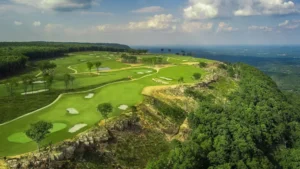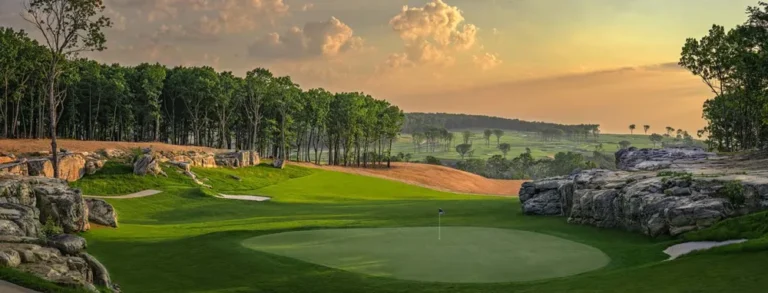When you first step onto The Keep, the new course at the McLemore Resort and community in northwest Georgia, it is impossible not to be struck by its incredible scale.
This story was originally reported by Golf Course Architecture magazine.
That’s partly because you can view almost the entire course from any point. But more because beyond the course’s cliff edges, along which five holes play, there are 70-mile views from 1,000 feet above the valley floor of McLemore Cove.

The vistas from the appropriately named Lookout Mountain had already been opened to McLemore’s golfers following the Bill Bergin-Rees Jones redesign of its first course, the Highlands, which was completed in 2019 and included the creation of an entirely new cliff-edge finishing hole.
“The new eighteenth put us on the map,” says Duane Horton, president of Scenic Land Company, the developer of McLemore. “I will never forget the day Bill went over the edge of our upper plateau and disappeared into the thick woods and underbrush, only to pop up later with scratches from briars, soaked in sweat and the biggest smile, saying, ‘we are going to make it happen.’”
For more than a decade Horton has been eyeing land to the south of the resort – with the idea of expanding McLemore’s residential community. The success of the Highlands redesign shifted his thinking to the creation of more golf. Horton says he was driven by the desire to create “an impossible combination of a links-inspired, mountaintop, cliff-edge golf course.”
Once he had acquired the land, Horton had no hesitation in returning to Bergin and Jones for the design. “It was like seeing children on Christmas Day,” says Horton, of their first visit to the site.
“It stands alone in scope, size, location and first impression,” says Bergin. “It is hard to describe the scale – even a camera can’t quite capture the immense distance and depth of the valley.”
Jones agrees: “It is one of the world’s great sites for golf. It doesn’t compare with anything I’ve done because it doesn’t compare with anything that anybody’s done.”
Horton gave the design team some key requirements for the routing: there should be clubhouse ‘outposts’ at the northern and southern points of the property, and the eighteenth green was to be built on a specific point on the cliff edge.

Bergin, working alongside his son Matt, created the initial course routing and collaborated with Jones and his long-term associate Steve Weisser to fine-tune the strategy for the course. Both teams shared the task of developing green and bunkering concepts – with each taking on nine holes. Once the concepts were finalised, they came together to share notes and continued to refine the design on-site.
“We had an eclectic set of greens plans and some contrasting bunker styles,” says Bergin. The team then worked together on connections between holes and consistency of features. “Rees was influential on the design of bunkers – we have a windswept style, which is appropriate for the scale and location of The Keep. He also recommended some additional, strategic bunkers. It’s a well bunkered course – they follow the three forms of bunker art I look for: a nice crestline, sand line and face movement.”
Better Billy Bunker was chosen for lining, helping to deliver consistent performance and playability of hazards
The diversity in the architects’ green designs remains. “We have some cool greens, but they’re not crazy severe,” says Weisser. “They’re all different and you really notice how interesting they are when you play them. Most of them are receptive to the ground game, which is going to be important on days when the wind blows. They are also quite large with plenty of variety in terms of contours and pin positions.
“We have also designed runoff areas that act both as hazards and containment zones, saving you from worse positions or losing a ball. We’ve varied them up a bit, some are fairway cut while others are almost like a semi rough, and then there’s fescue beyond these turf areas.”
With the design finalized, contractor Southeastern Golf began construction in autumn 2022.
The first task was to clear hundreds of trees from the rocky site, opening up a mountaintop plateau that is a marked contrast from the Highlands layout, where holes weave through woodland and navigate considerable changes in elevation.
For most mountain golf, construction can be a matter of blasting rock to achieve playable tiers. But the property for The Keep is not typical: it has an open plateau that has a more gentle tilt towards the cliff edge, rather than severe rise and fall. “You play through the site’s folds,” says Weisser.
There are five points on the course – the second green, and then tees on eight, thirteen, sixteen and eighteen – that require a gentle ascent to reach. But these spots, Bergin points out, afford some of the most spectacular views.
“Connections between tees and greens are close,” adds Weisser. “You’re not fighting the mountain as you go around. It’s not a climb-a-mountain course.”
“We made two big fills, otherwise the course fits perfectly on the ground,” says Bergin. “We had a rock hammer running for two years, breaking them up so we could run irrigation and drainage lines. We did more rock hammering than I anticipated, but less blasting.”
Jones adds: “The Keep flows perfectly with the ground. We didn’t blast away the rocks to turn the place into something else, we maintained the mountain style. Fortunately, the rock presented itself in the right locations, especially on the final two holes.”
On the seventeenth, outcroppings of rock have been incorporated to particularly spectacular effect, creating an amphitheater for the green of this relatively short par four that plays uphill. “It is the most unique rock Colosseum green complex you’ll find anywhere,” says Bergin. And on the eighteenth, tees among the rock set up an inviting elevated shot back down the slope towards the final green on the cliff. “The beauty of those holes is that they tell you where you are,” says Jones.
Wind, while not usually severe, can be a factor at The Keep. “We planned for a very big golf course because the site calls for that, the views call for that,” says Bergin. “The scale of the layout means it can handle the wind beautifully, there was a little bit of serendipity about it because we planned for big fairways. There’ll be days when it’s calm and you feel like you can hit every fairway, but when the wind blows, you’ll be thankful for the room, angles and for places to hit the ball safely.”
The closing hole is a good example. “There is a strong left-to-right breeze that pushes balls towards the cliff-edge,” says Bergin. “While there is more room than it appears, at first glance players will think they need to aim well to the left. Due to the hole’s width and the ever-present wind, the eighteenth at The Keep will play as one of the most diverse holes on the course.”
The cliff-edge holes come at the start, middle and end of the round. After the opening tee shot of the day, golfers are faced with an approach over a chasm that sets the tone for the round. The next visit is after holing out on the infinity green of the par-three eighth, for a three-hole stretch that may induce vertigo: the par-four ninth and par-five tenth play right along the mountain’s edge, then the par-three eleventh requires a mid-iron to a green that falls away at the front and left.
At that point, golfers may be relieved to turn inland. And one huge success of the design is the interest and variety offered away from the cliffs, with each of those holes presenting a distinct identity and challenge.
The split-fairway second hole has been the biggest surprise for the owners. Bergin says: “It was the last hole we built as we used the area as our haul road, access point and staging area. Rees and I had the vision to know what it would become. If you play left, it plays longer but hit your ball right and there’s more risk. A wetland slices down the middle of the hole and six beautiful bunkers are visible from every point.”
Jones too believes the inland holes will become favorites among members and returning golfers. “The par-three third, which has a creek running along it, would, on any other course, be the hole they talk about the most,” he says. “The sixth is a great hole where most people will play to the right because that’s the way it is set up. But if you play left, it is a wedge in over water.”
Water also comes into play on the thirteenth and fourteenth holes, the former a long par-four that demands an approach over a stream and a lake to be avoided on the right. The cautious approach will favors the left of the green, where a shortgrass bailout area gives the best chance of recovery. The par-three fourteenth has a stream to the right. Pin position will have a significant impact on difficulty – a feature throughout the course.
As former PGA Tour player Charlie Rymer, now executive vice president of McLemore, points out: “Every hole has drama, consisting of an incredible view and decisions that need to be made. We have five of the most incredible skyline shots you will ever see – there is nothing like seeing a flagstick up against an unending magnificent backdrop.”
Its dramatic mountaintop setting and astonishing vistas will inevitably and deservedly catapult The Keep into the golfing world’s attention. But the course has substance; layers to peel back and new secrets to discover, in the unlikely event that you become accustomed to the views.


